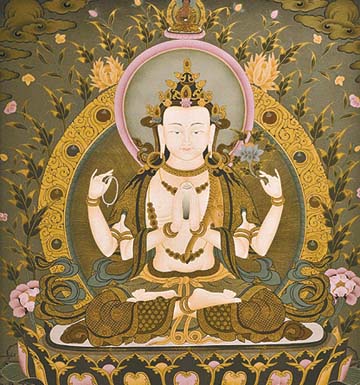|

Newman Huo, Linglin Zhu
IN his thangka titled “Four-armed Guan Yin” (“The Bodhisattva of Compassion”), Luosang Danzeng, 26, a painter from Lhasa, the capital of the Tibet Autonomous Region, has boldly applied a kind of grey background, which makes his work very special.
Against an exquisite background, the four-armed listener of the world’s ills who uses skillful means to come to needy people’s aid dominates the center of the painting and is surrounded by a group of other Bodhisattvas and flying angels in four corners.
“I would like to say that my painting is a rare type of grey thangka or painting with grey background, which is different from more common and popular types of red thangka or painting with red background, and colored thangka, which is painted in colors,” the young painter said in an interview Thursday.
At the age of 11, Luosang Danzeng started to learn the thangka art from his father Suolang Duoji, a renowned artist of the Miantang School, who is now running his workshop in Lhasa.
Compared with his father who sticks to the traditions of Tibetan painting, Luosang Danzeng appears to be more innovative.
The young painter and his father’s paintings are now being displayed at the “Harmonious Light and Auspicious Sign: Tibetan thangka Art” exhibition in Guan Shanyue Art Museum.
The exhibition, scheduled to run through April 24, features 130 thangka paintings by contemporary Tibetan painters.
Participating artists from different areas of Tibet represent two leading schools of the thangka art, such as the Miantang School and Miansa School.
Listed as one of China’s national intangible cultural heritages, thangka represents a traditional Tibetan art with its sophisticated skills, high artistic value, and profound cultural background.
In Tibetan, “Thang” means “unfolding” or “displaying,” and thangka means “silk, satin or cloth painting scroll.” So thangka is a Tibetan scroll painting with embroidery, usually depicting a Buddhist deity.
Different from traditional Chinese ink painting or Western oil painting, thangka actually consists of a picture panel which is painted or embroidered, over which a textile is mounted, and then over which is laid a silk cover.
Commonly seen at every monastery and family shrine in Tibet, thangka is a mark of devotion to Tibetan Buddhism and often serves as an object of worship.
Nobody knows exactly where and when thangka originated, but compared with other Tibetan arts, the history of thangka can be traced back to as early as the Tubo period or Songtsen Gampo period, as a combination of Nepalese painting, Kashmiri painting and Chinese scroll painting.
Until the 7th century, Songtsen Gampo united the whole of Tibet, and hence a new period in Tibetan history began.
Later, Songtsen Gampo married Princess Bhrikuti of Nepal, daughter of King Lichchavi, and Prince Wencheng of the Tang Dynasty, further strengthening connections between Tibetans, Nepalese, and the Han people.
The two princesses came to Tibet with a lot of Buddhist scriptures, and many skilled artisans, greatly stimulating the development of Tibetan society, especially the flourishing of Tibetan Buddhism.
By then, mural or wall paintings alone could not satisfy the needs of Buddhist monks and believers. So thangka, as another kind form of art easy to carry, hang and collect, appeared and popularized in Tibet.
By the mid-11th century, three major thangka schools, including the Miantang School (Classic School), Miansa School (Changdu School) and Gama Gachi School (Kangba School) began to show up with the expansion and spread of different denominations of Tibetan Buddhism.
Historians note that Chinese painting had a profound influence on the thangka art. Starting from the 14th century, Tibetan painting had incorporated many elements from the Chinese, and during the 18th century, Chinese painting had made a deep and far-stretched impact on Tibetan visual arts.
During the Ming and Qing dynasties (1368-1911), the central government adopted the system of approving Tibetan chieftains to strengthen their control over Tibet, which made a great contribution to the development of Tibetan society.
The Ming and Qing dynasties saw great progress in the development of the thangka art. Most of the ancient thangkas that exist today were made during the two dynasties.
The content of thangkas has various subjects, such as historical events, folklore, mythical stories, Tibetan landscapes and social customs, and images of great deities and Buddhas.
Dominated by the theme of Tibetan Buddhism, thangkas often overflow with symbolism and allusion, and artists must follow the sacred laws for portraying gods and Buddhas.
A thangka painter must be properly trained and have sufficient religious understanding, and knowledge to create an accurate and appropriate thangka.
However, only rarely do thangkas express the personal vision or creativity of the painter and for that reason thangka painters have generally remained anonymous as have the tailors who made their mountings.
Dates: Through April 24
Hours: 9 a.m.-5 p.m. Closed Monday
Venue: Guan Shanyue Art Museum (关山月美术馆)
Add: 6026 Hongli Road, Futian District (福田区红荔路6026号)
Buses: 10, 14, 25, 34, 105, 111, 215, 228, 238, 322, 350, 371
Metro: Shao Nian Gong Station (Children’s Palace Station 少年宫站), Exit B
|

